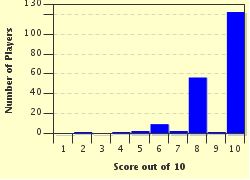Quiz Answer Key and Fun Facts
1. Material used for building homes
2. Typical crop grown by Puebloans
3. System of tracing descent
4. Literally means "towns"
5. Type of agriculture found in Pre-Columbian American Southwest
6. Elevated land with steep cliffs
7. The practice of marrying one's own clan members
8. Room for rituals and public meetings
9. A spirit
10. Story of how world began
Source: Author
ponycargirl
This quiz was reviewed by FunTrivia editor
stedman before going online.
Any errors found in FunTrivia content are routinely corrected through our feedback system.

